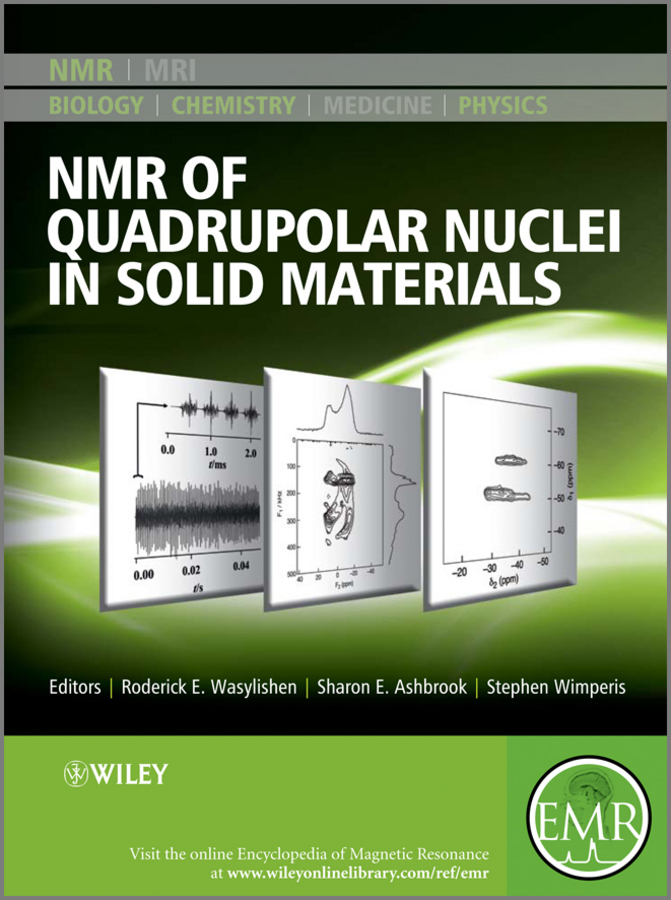Электронная книга: Stephen Wimperis «NMR of Quadrupolar Nuclei in Solid Materials»

|
The content of this volume has been added to eMagRes (formerly Encyclopedia of Magnetic Resonance)– the ultimate online resource for NMR and MRI. Over the past 20 years technical developments in superconducting magnet technology and instrumentation have increased the potential of NMR spectroscopy so that it is now possible to study a wide range of solid materials. In addition, one can probe the nuclear environments of many other additional atoms that possess the property of spin. In particular, it is possible to carry out NMR experiments on isotopes that have nuclear spin greater that ½ (i.e. quadrupolar nuclei). Since more that two-thirds of all NMR active isotopes are quadrupolar nuclei, applications of NMR spectroscopy with quadrupolar nuclei are increasing rapidly. The purpose of this handbook is to provide under a single cover the fundamental principles, techniques and applications of quadrupolar NMR as it pertains to solid materials. Each chapter has been prepared by an expert who has made significant contributions to out understanding and appreciation of the importance of NMR studies of quadrupolar nuclei in solids. The text is divided into three sections: The first provides the reader with the background necessary to appreciate the challenges in acquiring and interpreting NMR spectra of quadrupolar neclei in solids. The second presents cutting-edge techniques and methodology for employing these techniques to investigate quadrupolar nuclei in solids. The final section explores applications of solid-state NMR studies of solids ranging from investigations of dynamics, characterizations of biological samples, organic and inorganic materials, porous materials, glasses, catalysts, semiconductors and high-temperature superconductors. About EMR Handbooks / eMagRes Handbooks The Encyclopedia of Magnetic Resonance (up to 2012) and eMagRes (from 2013 onward) publisha wide range of online articles on all aspects of magnetic resonance in physics, chemistry, biology and medicine. The existence of this large number of articles, written by experts in various fields, is enabling the publication of a series of EMR Handbooks / eMagRes Handbooks on specific areas of NMR and MRI. The chapters of each of these handbooks will comprise a carefully chosen selection of articles from eMagRes. In consultation with the eMagRes Editorial Board, the EMR Handbooks / eMagRes Handbooks are coherently planned in advance by specially-selected Editors, and new articles are written (together with updates of some already existing articles) to give appropriate complete coverage. The handbooks are intended to be of value and interest to research students, postdoctoral fellows and other researchers learning about the scientific area in question and undertaking relevant experiments, whether in academia or industry. Have the content of this Handbook and the complete content of eMagRes at your fingertips! Visit: www.wileyonlinelibrary.com/ref/eMagRes View other eMagRes publications here Издательство: "John Wiley&Sons Limited"
ISBN: 9781118588857 электронная книга Купить за 15983.98 руб и скачать на Litres |
Другие книги схожей тематики:
| Автор | Книга | Описание | Год | Цена | Тип книги |
|---|
См. также в других словарях:
Solid-state nuclear magnetic resonance — (NMR) spectroscopy, characterized by the presence of anisotropic (directionally dependent) interactions.IntroductionBasic conceptsA spin interacts with a magnetic or an electric field. Spatial proximity and/or a chemical bond between two atoms… … Wikipedia
Nuclear magnetic resonance — This article is about the physical phenomenon. For its use as a method in spectroscopy, see Nuclear magnetic resonance spectroscopy. NMR redirects here. For other uses, see NMR (disambiguation). First 1 GHz NMR Spectrometer (1000 MHz,… … Wikipedia
Magic angle spinning — Magic angle spinning: The sample (blue) is rotating with high frequency inside the main magnetic field (B0). The axis of rotation is tilted by the magic angle θm with respect to the direction of B0. In nuclear magnetic resonance, magic angle… … Wikipedia
Deuterium — Hydrogen 2 Full table General Name, symbol deuterium, 2H or D Neutrons 1 … Wikipedia
Molecular dynamics — (MD) is a computer simulation of physical movements of atoms and molecules. The atoms and molecules are allowed to interact for a period of time, giving a view of the motion of the atoms. In the most common version, the trajectories of molecules… … Wikipedia
Xenon — (PronEng|ˈzɛnɒn [Xenon, entry in the Oxford English Dictionary, prepared by J. A. Simpson and E. S. C. Weiner, vol. 20, second edition, Oxford: Clarendon Press, 1989. ISBN 0 19 861232 X (vol. 20), ISBN 0 19 861186 2 (set.)] or IPAlink en|ˈziːnɒn… … Wikipedia
